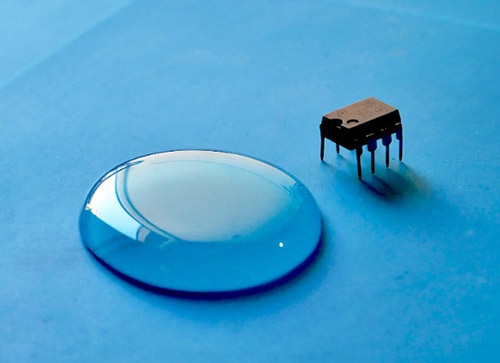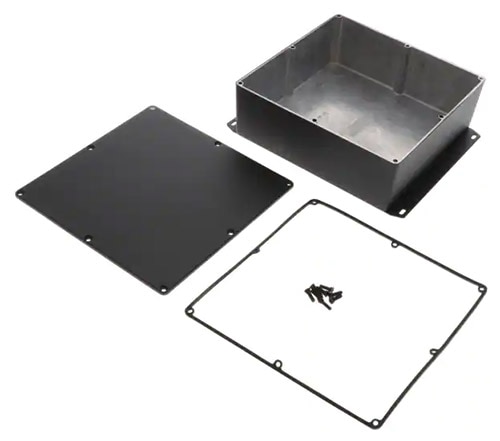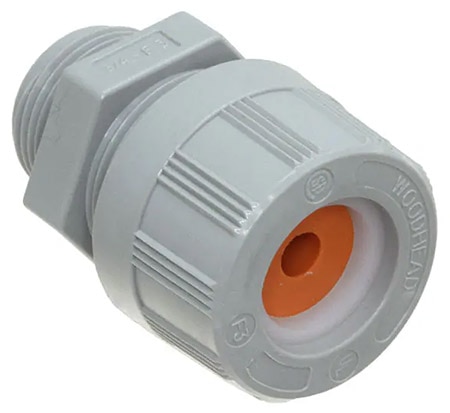Common Methods to Protect Electronics Projects from Water and Dust
2023-06-07 | By Maker.io Staff
A recent article unraveled the meaning of ingress protection (IP) classes and how we can utilize these ratings to choose an enclosure that fits our needs. With that in mind, this article discusses various methods to water- and dust-proof electronics projects to protect them against taking damage from the environment.

Using a Suitable Electronics Enclosure
The most straightforward approach to protecting an electronics project is using a pre-made case with an IP rating according to the project’s requirements. Nowadays, we can choose from various enclosures in different sizes, shapes, and colors that offer protection in multiple scenarios. Typically, more cost-effective cases protect the electronics against accidental touching and large objects, while higher-end enclosures can often provide water intrusion protection even after prolonged submersion.
 Suitable enclosures provide a gasket that protects the internals from dust and water.
Suitable enclosures provide a gasket that protects the internals from dust and water.
Using a case is often ideal when the project has a relatively large physical size and can operate autonomously from within a fully enclosed box. However, that means that the project should include a dedicated power source (e.g., a battery), and everything it needs should fit within the enclosure to prevent external connections from compromising the protective properties of the case. In addition, you should note that cases with higher IP ratings offer little to no airflow that could cool the electronic components.
Examples of projects that could benefit from a protected enclosure include self-contained and battery-operated sensor units that collect data autonomously and transmit the results periodically to a server via a wireless connection.
Protecting Connections
As many projects will not operate independently from other devices, we sometimes have to add wires that connect the electronics to a power supply or other devices for communication. In this case, we should utilize special connectors that provide either the same or a higher IP rating as the enclosure we use to ensure that the electronics are protected.
Typically, such connectors comprise a receiving unit (permanently mounted to the case or PCB) and a plug that can be detached. Together, the plug and receptacle form a seal that protects the wires and the electronics according to the IP rating of the connector.
In addition, remember that some projects require user input. In these cases, it’s vital that all physical switches, buttons, and other I/O elements are protected and that all holes cut into the enclosure are insulated with either fitting o-rings or other means – for example, by sealing the hole using hot glue or epoxy resin.
Feed Wires into Protected Enclosures
One downside of such plugs and receptacles is their price and physical size. Such connection systems are often higher cost and bulky, making them less ideal in cost-effective and space-saving applications. In this case, we can drill one or multiple holes into the enclosure we want to use for the project and then employ rubber grommets or a cable grip to seal the holes. These specialized parts contain smaller holes that allow wires to pass in and out of the project’s enclosure without compromising the protection the case offers.

Such grommets and grips are ideal for use in smaller and more cost-aware applications. However, the small rubber pieces may not protect sufficiently against prolonged submersion, chemicals, high temperatures, and high-pressure water jets. In addition, you must ensure that the grommets match the hole in the enclosure and the diameter of the wires for the grommets to provide a good seal.
Use Special Coating Materials
As an alternative to sophisticated enclosures and connectors, we could coat the entire project or certain parts in a water- and dust-repelling material such as epoxy resin, acrylic, or silicone. Something as simple as candle wax can also provide protection in a pinch.
This option is advantageous in small projects or when protecting little components like breakout boards from the elements. However, it’s important to note that covering components in any of these materials will completely inhibit airflow to the parts, potentially causing damage to devices that get warm or leading to malfunctions in sensors. In addition, these materials can be quite costly, so covering large surfaces is typically not advisable. Furthermore, applying many of these materials is sometimes a permanent alteration, meaning removing them afterward is usually impossible or difficult, requiring special solvents.
Finding the Right Protection for Your Project
We can choose from various methods when protecting our precious electronics projects from the environment. However, utilizing a pre-made enclosure is typically the easiest and safest option, and this approach should be a safe bet for most projects. In addition, various connection systems and rubber grommets can offer some flexibility and ensure that external connections don’t compromise the integrity and protection capabilities of the selected enclosure.
Some devices are too small to fit in a dedicated enclosure; in these cases, using a water-repellent material to cover the entire device is a good option. However, covering large projects in epoxy resin, for example, is typically not viable due to the cost.
As usual, there’s no universal solution that fits every project and situation, and you should experiment with various options to find the one that best suits your project.
Recommended Reading
Starting a New Design Check Out Digi-Keys Reference Design Library
There's No Such Thing as a Simple Component
Have questions or comments? Continue the conversation on TechForum, DigiKey's online community and technical resource.





